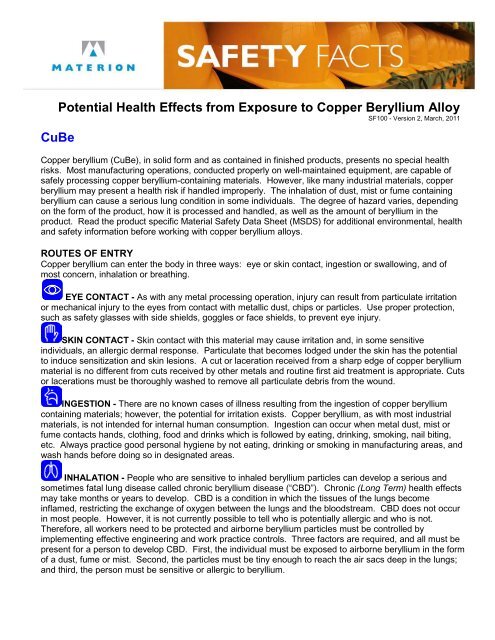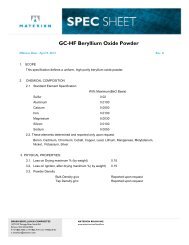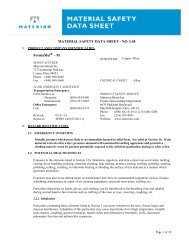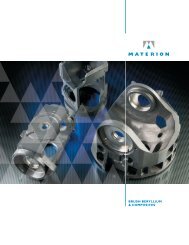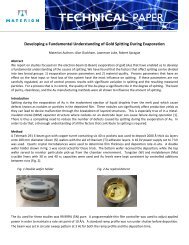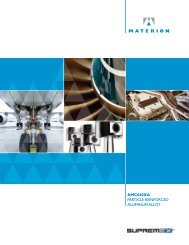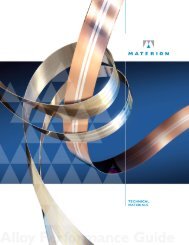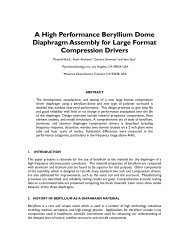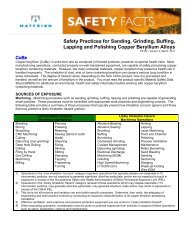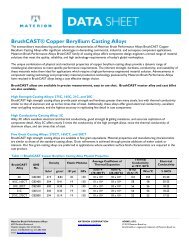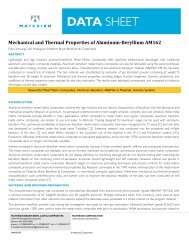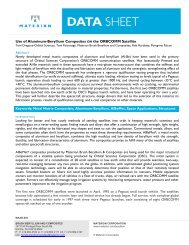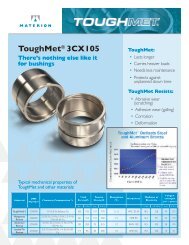Potential Health Effects of Exposure to Copper Beryllium - Materion
Potential Health Effects of Exposure to Copper Beryllium - Materion
Potential Health Effects of Exposure to Copper Beryllium - Materion
Create successful ePaper yourself
Turn your PDF publications into a flip-book with our unique Google optimized e-Paper software.
CuBe<br />
<strong>Potential</strong> <strong>Health</strong> <strong>Effects</strong> from <strong>Exposure</strong> <strong>to</strong> <strong>Copper</strong> <strong>Beryllium</strong> Alloy<br />
SF100 - Version 2, March, 2011<br />
<strong>Copper</strong> beryllium (CuBe), in solid form and as contained in finished products, presents no special health<br />
risks. Most manufacturing operations, conducted properly on well-maintained equipment, are capable <strong>of</strong><br />
safely processing copper beryllium-containing materials. However, like many industrial materials, copper<br />
beryllium may present a health risk if handled improperly. The inhalation <strong>of</strong> dust, mist or fume containing<br />
beryllium can cause a serious lung condition in some individuals. The degree <strong>of</strong> hazard varies, depending<br />
on the form <strong>of</strong> the product, how it is processed and handled, as well as the amount <strong>of</strong> beryllium in the<br />
product. Read the product specific Material Safety Data Sheet (MSDS) for additional environmental, health<br />
and safety information before working with copper beryllium alloys.<br />
ROUTES OF ENTRY<br />
<strong>Copper</strong> beryllium can enter the body in three ways: eye or skin contact, ingestion or swallowing, and <strong>of</strong><br />
most concern, inhalation or breathing.<br />
EYE CONTACT - As with any metal processing operation, injury can result from particulate irritation<br />
or mechanical injury <strong>to</strong> the eyes from contact with metallic dust, chips or particles. Use proper protection,<br />
such as safety glasses with side shields, goggles or face shields, <strong>to</strong> prevent eye injury.<br />
SKIN CONTACT - Skin contact with this material may cause irritation and, in some sensitive<br />
individuals, an allergic dermal response. Particulate that becomes lodged under the skin has the potential<br />
<strong>to</strong> induce sensitization and skin lesions. A cut or laceration received from a sharp edge <strong>of</strong> copper beryllium<br />
material is no different from cuts received by other metals and routine first aid treatment is appropriate. Cuts<br />
or lacerations must be thoroughly washed <strong>to</strong> remove all particulate debris from the wound.<br />
INGESTION - There are no known cases <strong>of</strong> illness resulting from the ingestion <strong>of</strong> copper beryllium<br />
containing materials; however, the potential for irritation exists. <strong>Copper</strong> beryllium, as with most industrial<br />
materials, is not intended for internal human consumption. Ingestion can occur when metal dust, mist or<br />
fume contacts hands, clothing, food and drinks which is followed by eating, drinking, smoking, nail biting,<br />
etc. Always practice good personal hygiene by not eating, drinking or smoking in manufacturing areas, and<br />
wash hands before doing so in designated areas.<br />
INHALATION - People who are sensitive <strong>to</strong> inhaled beryllium particles can develop a serious and<br />
sometimes fatal lung disease called chronic beryllium disease (“CBD”). Chronic (Long Term) health effects<br />
may take months or years <strong>to</strong> develop. CBD is a condition in which the tissues <strong>of</strong> the lungs become<br />
inflamed, restricting the exchange <strong>of</strong> oxygen between the lungs and the bloodstream. CBD does not occur<br />
in most people. However, it is not currently possible <strong>to</strong> tell who is potentially allergic and who is not.<br />
Therefore, all workers need <strong>to</strong> be protected and airborne beryllium particles must be controlled by<br />
implementing effective engineering and work practice controls. Three fac<strong>to</strong>rs are required, and all must be<br />
present for a person <strong>to</strong> develop CBD. First, the individual must be exposed <strong>to</strong> airborne beryllium in the form<br />
<strong>of</strong> a dust, fume or mist. Second, the particles must be tiny enough <strong>to</strong> reach the air sacs deep in the lungs;<br />
and third, the person must be sensitive or allergic <strong>to</strong> beryllium.
Small, respirable beryllium particles depositing on hands, gloves and clothing could be transferred <strong>to</strong> the<br />
breathing zone and inhaled during normal hand <strong>to</strong> face motions. Care should be taken not <strong>to</strong> <strong>to</strong>uch the face<br />
with contaminated hands or clothing. Wear proper personal protective equipment <strong>to</strong> prevent skin and<br />
clothing contact with beryllium particles. Wash hands if they become contaminated.<br />
CANCER - Although beryllium has produced tumors in some labora<strong>to</strong>ry animals, and is listed or suspected<br />
as a human carcinogen by some agencies, <strong>Materion</strong> Brush Inc. believes there is no credible evidence that<br />
beryllium causes cancer in humans. In fact, the American Conference <strong>of</strong> Governmental Industrial<br />
Hygienists recently stated their belief that the risk <strong>of</strong> cancer is low in modern beryllium manufacturing plants.<br />
However, because cancer research is continuing, <strong>Materion</strong> Brush Inc. recommends that caution be<br />
maintained since beryllium, like many other commonly used metals, has been listed by OSHA as a potential<br />
cancer hazard.<br />
ADDITIONAL INFORMATION<br />
The information contained in this Safety Facts applies only <strong>to</strong> the subject referenced in the title. Read the<br />
MSDS specific <strong>to</strong> the products in use at your facility for more detailed environmental, health and safety<br />
guidance. MSDSs can be obtained by contacting the <strong>Materion</strong> Brush Inc. Product Safety Hotline at (800)<br />
862-4118 or visit our website at www.materion.com.<br />
Additional information can also be obtained by contacting a <strong>Materion</strong> Brush Inc. Sales Representative or:<br />
Product Stewardship Department<br />
<strong>Materion</strong> Brush Inc.<br />
6070 Parkland Boulevard<br />
Mayfield Heights, Ohio 44124<br />
(800) 862-4118


